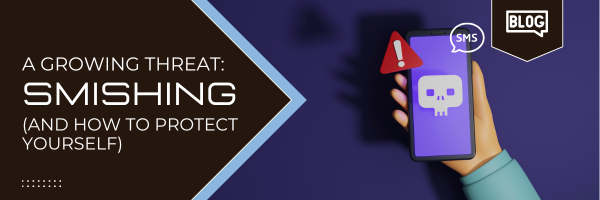Cyber threats are evolving rapidly. A popular one that is emerging is called smishing. As mobile phone usage continues to rise, so does the risk of falling victim to smishing attacks. In this blog post, we’ll explore the dangers of smishing and provide practical tips on protecting yourself.
What is Smishing?
Smishing, a blend of “SMS” and “phishing,” involves cybercriminals using text (SMS) messages to deceive individuals into revealing personal information or clicking on malicious links. These messages often appear to come from legitimate sources, such as banks, government agencies, or well-known companies – but it’s false. The goal is to trick recipients into providing sensitive information, such as passwords, credit card numbers, or social security numbers, or to click on links that install malware on their devices.
How Does Smishing Work?
Smishing attacks are typically made up of the following steps:
- Crafting a Deceptive Message: Cybercriminals create a convincing message that appears to be from a trusted source like Amazon or FedEx. The message may contain urgent language, such as “Your account has been compromised” or “Verify your information immediately.”
- Sending the Message: The deceptive message is sent to a large number of recipients, hoping that some will “take the bait.”
- Collecting Information: If a recipient responds to the message or clicks on the link, they may be directed to a fake website designed to steal their information or download malware onto their device.
Real-World Examples of Smishing
- Banking Scams: A text message claiming to be from your bank asks you to verify your account details by clicking on a link. The link leads to a fake website that captures your login credentials. This is NOT something a bank would do with your private data.
- Delivery Scams: You receive a message stating that a package delivery has been delayed and you need to click on a link to reschedule. The link installs malware on your device.
- Government Scams: A message pretending to be from a government agency claims you owe taxes and must pay immediately by clicking on a link or calling a phone number.
How Do I Protect Myself from Smishing?
- Be Skeptical of Unsolicited Messages: If you receive a text message from an unknown sender or a message that seems even a bit suspicious, DO NOT respond or click on any links. Report any suspicious messages immediately to your mobile carrier and the organization being impersonated.
- Verify the Sender: Contact the organization directly using a known, trusted method (e.g., official website or phone number) to verify the message’s legitimacy.
- Avoid Sharing Personal Information: Never provide personal or financial information in response to an unsolicited text message. Reputable organizations will NOT ask for this type of information via text message.
- Use Security Software: Install and regularly update security software on your mobile device to detect and block malicious messages.
Smishing is a growing threat, but by staying informed and vigilant, you can protect yourself from becoming a victim, both personally and in the workplace. By following these tips, you can help ensure your mobile device and personal data remain secure.
If you have questions about smishing or you think you might have become a victim of it, don’t hesitate to reach out to us. As a managed services provider, we can help protect your employees from dangerous cyber threats like smishing. Call us at 410-860-9899 or click here to schedule a consultation.
